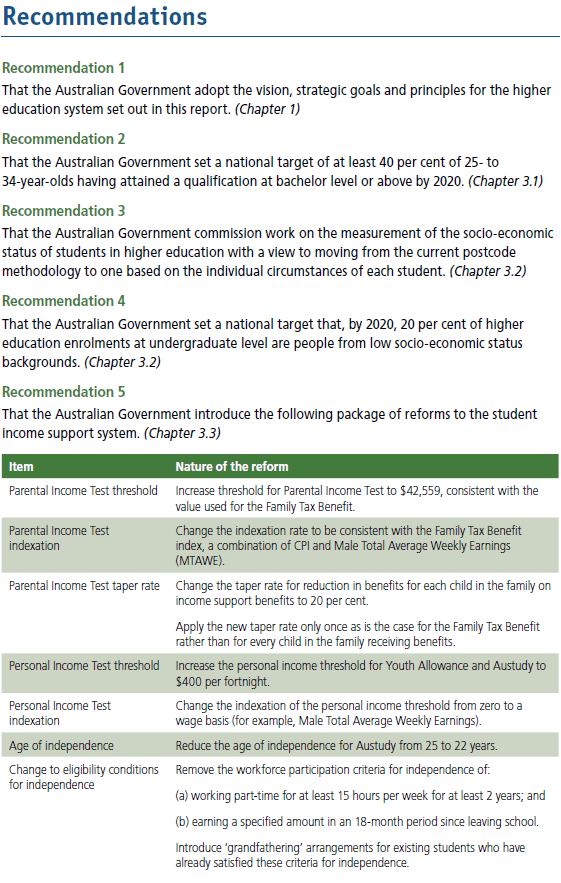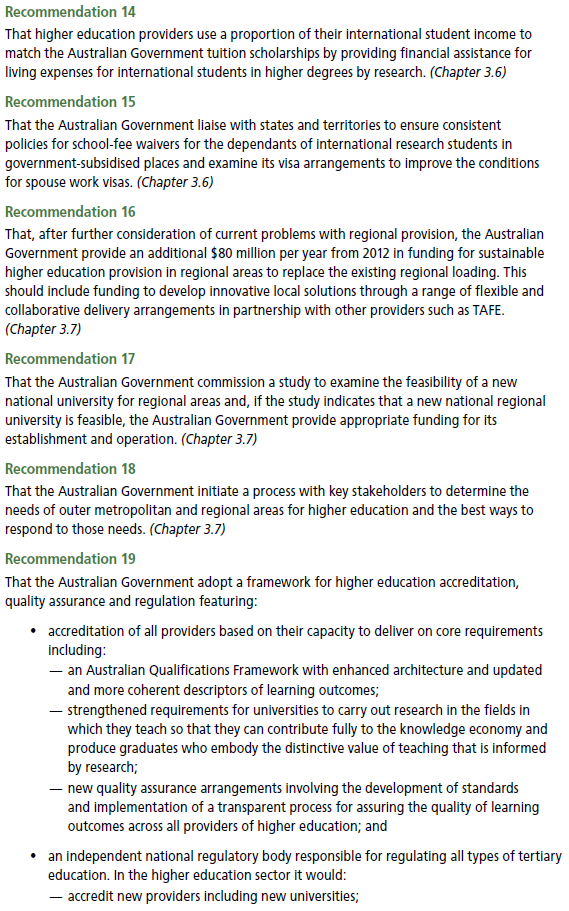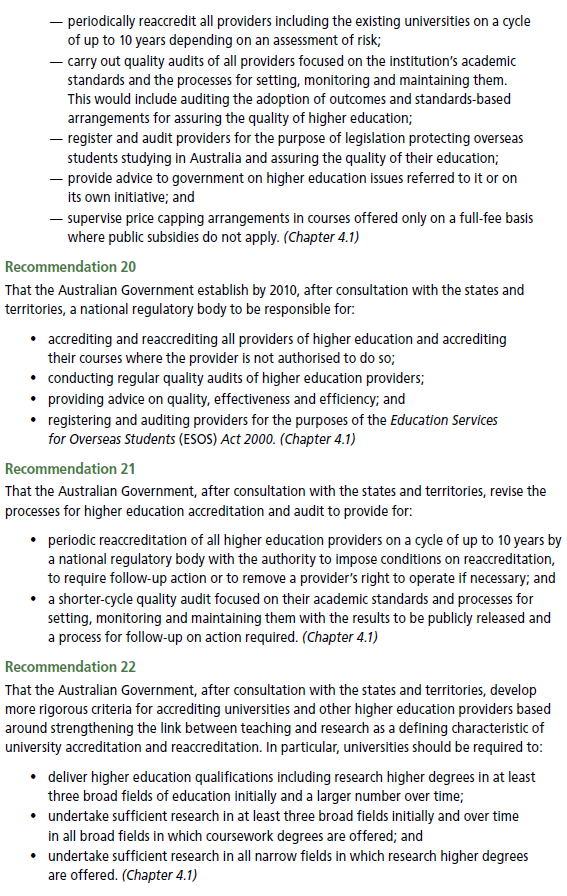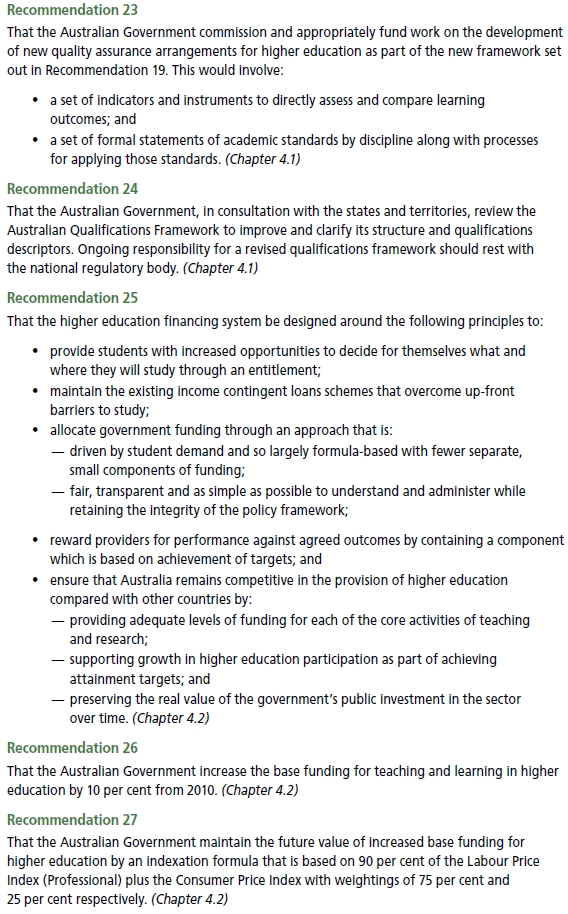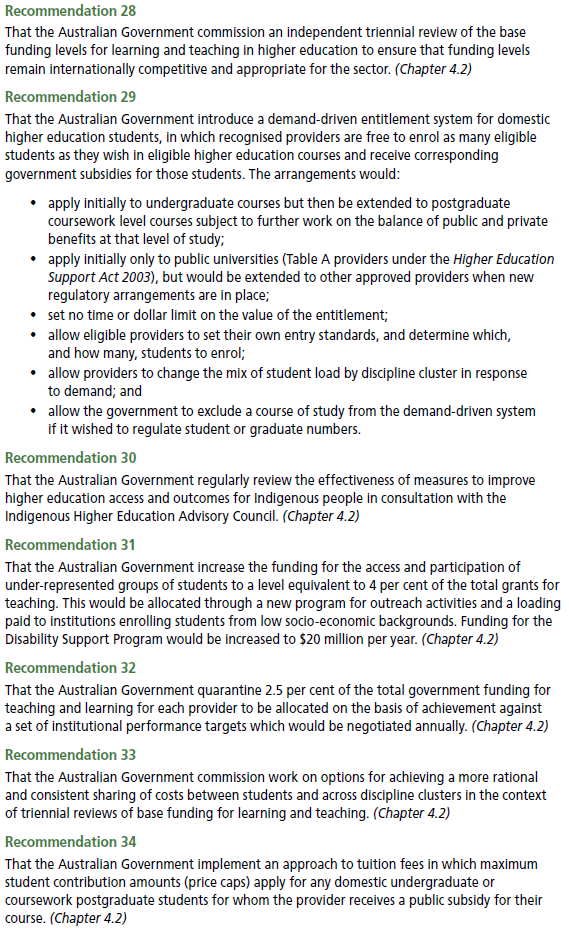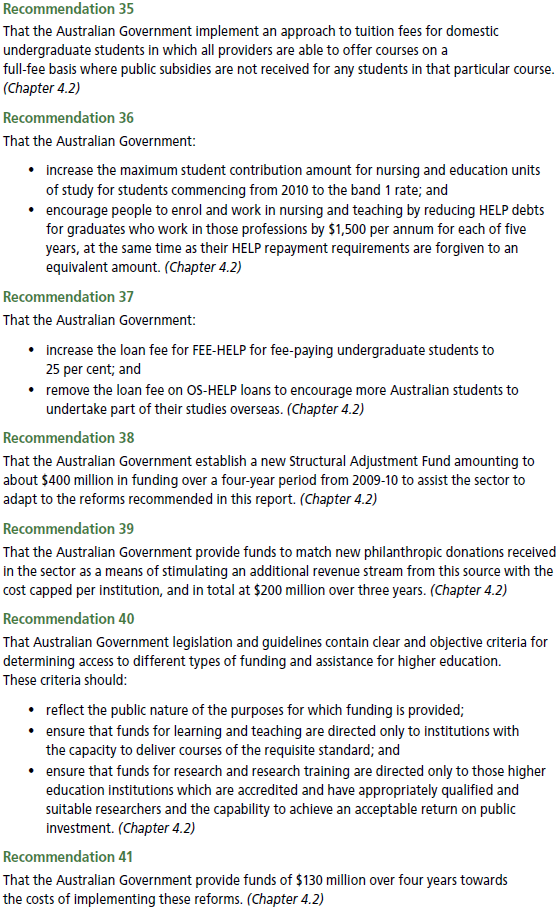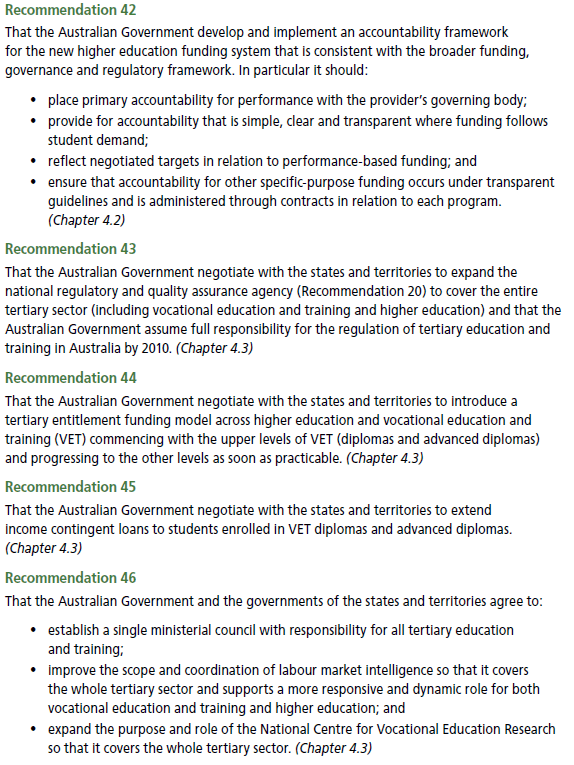|
|
|
|
|
|
|
News & Views item - December 2008 |
![]() The
Bradley Review Sees Daylight. The Education Minister, Julia Gillard, Says She
Will Respond By March. (December 17, 2008)
The
Bradley Review Sees Daylight. The Education Minister, Julia Gillard, Says She
Will Respond By March. (December 17, 2008)
 The
304-page final report of the
Review of Australian Higher Education chaired by
Professor Denise Bradley was published this morning.
Its bottom line: "Boost public funding of the sector by $5.75 billion over the
next four years."
The
304-page final report of the
Review of Australian Higher Education chaired by
Professor Denise Bradley was published this morning.
Its bottom line: "Boost public funding of the sector by $5.75 billion over the
next four years."
It also recommends introducing what is to all intents a voucher system for student funding but eschews detail, a matter of consequence if course popularity is to be held in check to allow learning and research for the public good in the long as well as medium term to be able to compete.
The review shies away from rigorous recommendations of detailing approaches to rebuilding the university sector but rather dwells on the need for critical assessment and accreditation of its institutions, ensuring that they meet increasingly exacting standards as determined by a national independent board to be established.
So for example it suggests that an institution that teaches a subject must also research in that area. Now you can have lots of fun developing different interpretations for meeting that requirement, or avoiding not meeting it. Obviously they are not the same thing.
Nevertheless the scope of the Bradley review allows the Rudd government, should it choose to do so, to "revolutionarily" revitalise the university sector.
Below are extracts of the report's executive summary followed by its forty-six recommendations.
The review
was established to address the question of whether this critical sector of
education is structured, organised and financed to position Australia to compete
effectively in the new globalised economy. The panel has concluded that, while
the system has great strengths, it faces significant, emerging threats which
require decisive action. To address these, major reforms are recommended to the
financing and regulatory frameworks for higher education.
There
are now 37 public universities, two private universities and 150 or so other
providers of higher education. The public universities derive significant
proportions of their income from non-government sources and some private
providers receive government subsidies. The public-private divide is no longer a
sensible distinction.
Australia is
losing ground. Within the OECD we are now 9th
out of 30 in the
proportion of our population aged 25 to 34 years with such qualifications, down
from 7th
a decade ago.
Twenty nine per cent of our 25- to 34-year-olds have degree-level qualifications
but in other OECD countries targets of up to 50 per cent have already been set.
These policy decisions elsewhere place us at a great competitive disadvantage
unless immediate action is taken.
We also face
difficulties with provision of higher education in regional areas where there
are thin markets which will not sustain a viable higher education presence.
There are
now clear signs that the quality of the educational
experience
is declining; the established mechanisms for assuring quality nationally need
updating;
and student-to-staff ratios are unacceptably high.
A quarter of
our higher education students are from other countries and they make an enormous
contribution to our economy, our relationships with the region and our demand
for graduates. However, their concentration in a relatively narrow range of
subject fields, in levels of study and by country of origin poses significant
challenges both to institutions and to the long-term viability of the industry.
There is
abundant evidence that government provision of funds for underlying
infrastructure to support research in universities is very significantly below
the real costs. This is leading to a pattern of quite unacceptable levels of
cross-subsidy from funds for teaching, adversely affecting the quality of the
student experience.
Analysis of
our current performance points to an urgent need for both structural reforms and
significant
additional investment. In 2020 Australia will not be where we aspire to be – in
the
top group of
OECD countries in terms of participation and performance – unless we act,
and act now.
Turning to
the matter of what needs to be done the review points to recommended targets:
The target
proposed for higher education is that 40 per cent of 25- to 34-year-olds will
have attained at least a bachelor-level qualification by 2020. This will be
quite testing for Australia’s current attainment is 29 per cent.
By 2020, 20
per cent of undergraduate enrolments in higher education should be students from
low socio-economic backgrounds.
[F]unds will
follow the student, not be allocated to the institution. All qualified
individuals will have an entitlement to undertake an undergraduate qualification
unlimited in duration or value.
All
institutions in receipt of Commonwealth funds for teaching will be expected to
establish initiatives to increase both the enrolment of, and success of,
students from disadvantaged backgrounds.
[A]n
additional allocation of $80 million per year to develop innovative,
collaborative, local solutions to provision of higher education in regional and
remote areas is recommended.
The panel
recommends establishment of a whole-of-government approach, in partnership with
the providers in the industry and the movement of regulation of the industry to
an independent body.
Australia is
the only OECD country where the public contribution to higher education remained
at the same level in 2005 as it had been in 1995.
A
significant increase in public investment and funding for higher education is
warranted. An increase of 10 per cent to the base grants from the Commonwealth
for teaching will begin to reduce student-to-staff ratios to a more reasonable
level and have some effect upon casualisation of the academic workforce.
[A] move
from 22 cents to 50 cents in the dollar will benefit not just the research
enterprise but should also redirect resources to teaching. There is evidence of
substantial cross-subsidy to research from funds for teaching domestic and
international students.
The more demand-driven, student-entitlement system will require a greater
focus on accreditation, quality assurance, evaluation of standards and use of
outcomes measures.
An
independent, national regulatory agency, with responsibility for all aspects of
regulation including that for international students is necessary.
Greater incentives and more support for high performing international
students to undertake research degrees in Australia and more places and better
support for domestic research degree students will assist us to deal with a
looming shortage of academics and researchers.
Finally the review recommended an amalgamation of the university and TAFE
systems --
a single level of
government and nationally regulated rather than two sectors configured as at
present. Such a model would deliver skills development in ways that are
efficient and fit for purpose to meet the needs of both individuals and the
economy. Responsibility for the funding and regulation of the tertiary education
and training system should rest with the Australian Government and the
independent regulatory agency should consolidate all regulatory functions across
this tertiary system.
